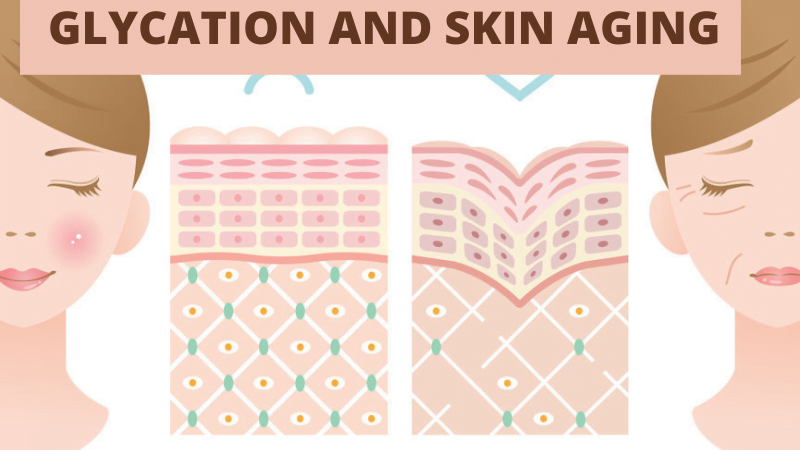
Glycation and Skin AGING
Glycation and Skin Aging
Glycation and Skin Aging. One of the first places you start to notice the build up of glycation is the skin.
Aging means the continual decline and decay of the body. If our body could repair faster than the decay we could slow or avoid aging.
The older we get the more damage we incurr. The first place you really start to notice ageing is the skin. The skin is made up of many layers. The outer layer is called the epidermis. This layer is made up of dead cells that are constantly being shed and replaced by new cells from below. When the body cannot repair skin damage faster than it occurs it continues to accumulate. Many things contribute to this and one in particular is the accumlation of glycation causing aging in the skin.
What is glycation in simple terms?
Glycation is caused by the combination of proteins and sugar molecules in the body. This combination leads to the formation of advanced glycation end products (AGEs). These AGEs accumulate with time and lead to several problems like loss of elasticity, wrinkling, sagging etc.
What does glycation do to the skin?
Glycation occurs in the epidermis layer as well as in the dermis (the second layer) but glycation in these layers cause different results. In the epidermis, glycation causes damage to collagen and elastin fibers which leads to wrinkles and loss of elasticity in this area. In the dermis, glycation damages collagen fibers which leads to sagging skin. Glycation also damages elastin fibers which leads to loss of elasticity in this area as well.
What is an example of Glycation process?
Enzymatic glycosylation can be defined using glucose nucleotide donors for glycoprotein synthesis. So what does this mean in layman terms? Glycation occurs when glucose bonds with proteins or fats at high temperatures or under high pressure conditions (like when frying food). This process causes damage to proteins and fats that are not normally damaged by heat alone (such as frying food). There are many factors that contribute to skin aging however glycation plays a MAJOR role in aging skin because it causes damage that cannot be reversed once it happens. But can it?
There are number of products on the market that support the body with specilised nutrients to go to work to support glycation and skin aging. One produt I have tried that has great visable results particlary for the visable signs of wrinkles, lines and dull skin is The Anti Glycation Extreme Pill also referred to as the AGE Pill or A.G.E. Pill.
Other factors that contribute to skin aging are UV radiation, smoking, pollution and stress. Thease are major contributing factors and one reason I always cover my face when out in the sun.
THE ROLE OF A.G.E.s (Advanced Glycated End Produts) DURING AGING.
What is the effect of AGING on the skin?
The effect of aging on the skin is that it makes the skin thinner, drier and more sensitive to UV radiation, cigarette smoke, pollution and stress. As we age our bodies are less able to repair damage that occurs in the body. This leads to a decline in our health as we age.
As previously mentioned the damage accumlates faster than the body can repair it. This process starts as young as 23 years of age in women and 25 in men. The most noticeable sign of aging is wrinkles on the face which is caused by glycation. Glycation also causes loss of elasticity which leads to wrinkles on other parts of the body such as arms and legs.
The Effect of AGEs on the body
AGEs also play a role in diabetes because they cause blood vessels to become stiff which leads to problems with circulation. AGEs also play a role in inflammation which leads to problems with the immune system. The impact of Advanced Glycated End products on the human body is far reaching as we age. AGE’s have been implicated in with many health issues.
According to one study our “modern diets are largely heat-processed and as a result contain high levels of advanced glycation end products (AGEs). Dietary advanced glycation end products (dAGEs) are known to contribute to increased oxidant stress and inflammation, which are linked to the recent epidemics of diabetes and cardiovascular disease.” PubMed Reference.
So where else do AGE’s come from?
You may be surprised to know that many foods cause glycation and some cause more damage than others.
Dietary AGEs
Dietary AGEs (Advanced Glycated End Products) are caused when we brown, baking and frying foods. Removing moisture from the food and causing a browning effect due to cooking creates AGEs. Foods that are high in AGEs include cooked chicken and beef. The best way to cook meat to minimise AGEs is to cook it lightly in water and then add sauce after cooking. Examples of foods high in AGEs include:
- Roasted or fried potatoes
- Browned or grilled meat, fish and poultry
- Baked goods such as breads and cakes
- Darker colas
If we want to minimise dietary AGEs the best way to cook food is lightly by steaming, poaching or stir-frying. The following foods are examples of food that have lower AGEs:
- Raw fruits and vegetables (best choice)
- Cold water fish such as tuna, salmon and sardines (steamed, broiled, or boiled, no browning)
- Chicken, turkey and pork cooked without browning, the way you cook the food makes a big differenece to the amount of Advanced Glycated End Products (AGEs) that are created .
This article only contains a snap shot of Glycation and Skin Aging, last week we shared: The Glycation Skin Guide: A Comprehensive Look at What Causes It and How to Fight Back.
Last Updated on March 27, 2023 by Katie Sisel Distributor
